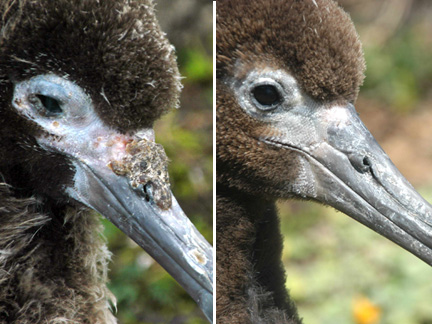
An albatross chick with pox, left, taken on April 4; and after treatment a month later, right.
Learn how to care
for injured birds
When you think about how often you see and hear birds, you realize how much they contribute to your everyday life. April through June is a busy season for birds as thousands of hatchlings are born every day. Caring citizens can take a role in improving birds' lives by volunteering to rescue and rehabilitate them, or simply educating others about when and when not to get involved with an injured or displaced bird.
Lend a handFlight is a bird's main defense against predators. If a bird is too young to fly or is injured, it may need your help. Here's what you can do:» Catch the bird gently in your hands and examine it to assess its condition. If the bird is bleeding, apply light pressure to the wound until it stops. Place the bird in a soft, padded container. » If you have a heating pad, place it under half of the container to provide the bird with heat. » A hungry baby can be given juicy bits of papaya or mango. » A naked baby bird needs warmth. It is highly susceptible to the cold. Give it a sugar-water mixture for energy by running your finger along its beak so the liquid can seep inside. A sick or injured bird can be hydrated the same way if it will not drink water. » Cover the container (allowing for air holes) and keep the bird in a quiet, warm, safe place until you can get assistance. » Contact Wild Bird Rehab Haven at 447-9274 or the Hawaiian Humane Society at 946-2187.
|
So what does wild-bird rehab involve? It's a time-intensive labor of love for those who appreciate birds. Volunteers can feed the birds, clean their cages and perform other important tasks. They may also need to clean wounds or prepare bandages. If the bird is young, feeding may be required every one to two hours. Raising a baby bird can span four months, from intake to release. Adult birds are usually released close to where they were found, because they know the area's water and food sources or may have a flock they can rejoin.
You don't have to be a volunteer to help wild birds. One simple thing you can do is to be conscious of nests in trees. If a family of birds is using the tree as a home, wait until after the birds have left the nest to trim tree branches.
If possible, return a fallen juvenile bird to its nest. Remember, parents can probably do a better job of raising the baby than humans. And it's a myth that a mother bird will abandon her young if they are touched by humans. If you cannot reach the nest, place the bird on a high branch to keep it away from predators. The bird's parents will be able to find it and feed it, even if it is not in the nest.
Many birds may leave their babies while they search for food. They will return, so it is best to leave the babies alone. If the bird can fly a little, the adult birds are probably nearby, teaching the baby how to fly. Not all fledglings are able to eat on their own and should ideally be returned to their nest.
If an hour or two passes and the parents have not returned, it is best that you take the bird's care into your own hands. Check for injuries under the wing and any broken bones from the fall. A hungry and crying bird can be fed baby bird formula, baby food or pureed fruits. It should be kept in a quiet, dark container to reduce stress.
THE SOCIETY also receives many calls about the Laysan albatross, large seabirds whose long wings are grayish brown. They are found in coastal areas such as Kaena Point. These and other birds are subject to avian pox, a virus that manifests itself in growths over the bird's face and eye area and is transmitted by mosquito bites. While the growths may look unappealing, it's important to know that birds can and do survive this virus in the wild and should not be moved from their habitats.
E-mail to Features Desk
[News] [Business] [Features] [Sports] [Editorial] [Do It Electric!]
[Classified Ads] [Search] [Subscribe] [Info] [Letter to Editor]
[Feedback]
